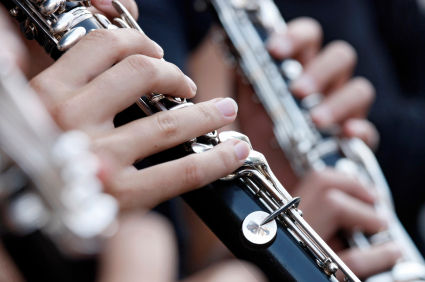Monday, December 1, 2014
IN THIS ISSUE:
The Great Set-up: Choosing the right mouthpiece for your clarinet students
by Wendy Benford
 Clarinet tone quality is a very popular topic of conversation amongst band directors and clarinetists alike. More often than not, the discussion turns toward the brand and strength of reeds their students use, the brand of ligature, air usage or embouchure formation and development. All three of these areas are of extreme importance if our clarinet players are going to be able to produce a beautiful sound that can blend easily within an ensemble; however, the component of the equation that typically gets very little discussion is the mouthpiece. As you will see in this article, it has become my opinion that there is not a "one size fits all" mouthpiece for an entire section and it is my hope that this article will provide some insight on why that is the case. I also hope to provide you with a bit of guidance on choosing the right mouthpiece for your clarinet students and, in turn, improve their tone quality and allow them to experience more success.
Clarinet tone quality is a very popular topic of conversation amongst band directors and clarinetists alike. More often than not, the discussion turns toward the brand and strength of reeds their students use, the brand of ligature, air usage or embouchure formation and development. All three of these areas are of extreme importance if our clarinet players are going to be able to produce a beautiful sound that can blend easily within an ensemble; however, the component of the equation that typically gets very little discussion is the mouthpiece. As you will see in this article, it has become my opinion that there is not a "one size fits all" mouthpiece for an entire section and it is my hope that this article will provide some insight on why that is the case. I also hope to provide you with a bit of guidance on choosing the right mouthpiece for your clarinet students and, in turn, improve their tone quality and allow them to experience more success.
Have you ever had a clarinet student who had a great embouchure and used good air support but got an airy tone quality despite the fact that they are playing the same mouthpiece on which other students play and can produce a clear, characteristic sound? How about a student whose dynamic range is limited between pianissimo and mezzo-piano? Or the student who struggles to play a four bar phrase at 120 beats per minute? I have had at least one student who fits the descriptions in each of these questions and in each case the students were playing on the same model of mouthpiece. As a result, I was quite baffled by the problem and decided to look for answers.
So, where do you begin? Choosing a clarinet mouthpiece can be a daunting task for anyone and most of us defer to our clarinet playing friends as to which mouthpiece is the "best"; I know I have been asked that question countless times in the past several years. The issue here is that there are numerous options and just as many opinions. Unfortunately, there is very little information available on how to choose what will work best for your students and more often than not teachers go through a trial and error process that can leave both you and your students (not to mention their parents) frustrated.
Not every student is the same.
You may wonder why I'm pointing out the obvious, but the reason is very simple -- every student possesses specific features that make them unique and in most cases these features will affect their needs as musicians. One of the first things that we as band directors notice when we first meet with our beginning band students is usually their teeth. We look for those things, not only because they are such strong identifying characteristics, but also because we know that it will dramatically determine, in many instances, which instrument that child will end up playing.
 Honestly, I never paid much attention to the teeth of students wanting to play clarinet until recently.
Honestly, I never paid much attention to the teeth of students wanting to play clarinet until recently.
I have come to understand that most students in the course of their middle school and high school years will have to deal with braces and that we will cross that bridge when we get there. However, over the past few years I've been paying much more attention to the dental make up of my clarinet students because I strongly believe that that alone is the basic determinate for which mouthpiece to select for them.
Choosing the right mouthpiece -- What makes the difference?
Let's think about this. People have one of three basic dental "bites" -- even bite, overbite/overjet or under bite/under jet. With each of these different bites, an individual's bottom teeth when the mouth is closed will either set close to even with their top teeth, a bit behind the top teeth or forward of the top teeth. In addition, you can have the extremes of each. This creates a unique problem for our young clarinetists.
We have all been shown the trick of slipping a piece of paper between the reed and the mouthpiece in order to determine where the bottom lip (while covering the bottom teeth) should meet the reed. That is very good advice and I highly recommend finding that fulcrum for all of your students. However, depending on the mouthpiece, the fulcrum will either be closer to the tip or further from the tip. Why is this important? If you have a student who has an extremely pronounced overjet and you place them on a mouthpiece with a medium to open tip, they cannot possibly hope to place their bottom lip anywhere near the fulcrum because it sits too far below the natural extension of their bottom teeth/ lip. In some cases this set up will yield no sound whatsoever. Conversely, if you have a student who has an even bite or an underjet and you place them on a more close-tipped mouthpiece, they will most likely get a bright, unfocused and uncontrollable sound because their bottom lip sits too far below the fulcrum and does not allow for proper control of the sound.
So how do you know which clarinet mouthpiece to choose for each student? Most mouthpiece manufacturers and makers have mouthpieces with a variety of tip openings. Instead of giving you a bunch of measurements, I think it will be better to speak in generalities. The following chart lists the mouthpieces I have found well suited for students with specific bites:
| Bite | Recommended Mouthpieces | |
| Even | Vandoren B45, Yamaha 5C | |
| Slight Overjet | Vandoren 5RV, Hite Premiere, Fobes Debut, Yamaha 4C | Approx 90% of students will fall into this category |
| Significant Overjet | Vandoren M13, Vandoren M13 Lyre | |
| Underjet | Vandoren M30 |
*This chart is not intended to be an exhaustive list of mouthpieces. There are many great mouthpieces on the market; these are simply the most popular mouthpieces used in my region of the country.
The process of choosing
The actual process is not really all that complicated. The first thing that I do when I sit down with my prospective clarinet students is ask them to give me a big, "toothy" smile. This allows me to see the posterior and anterior relationship between their upper and lower teeth and gives me some indication as to which mouthpiece(s) to try them on. Once I've selected one or two mouthpieces to try that correspond to the chart above, we go through the process of embouchure formation and then try the mouthpiece and barrel. I check for intonation -- can they play the F-sharp in tune on the mouthpiece and barrel alone? I also check for ease in blowing -- is there any tension present that could transfer to the instrument once the student begins playing? The goal is to achieve a full tone that is free of airiness or fuzziness.
Here's to great clarinet sound from the start!
 |
Wendy Benford Wendy Benford is in her twelfth year of teaching and is currently the band director for Bartlesville Mid-High School and Assistant Director at Madison Middle School in Bartlesville, Oklahoma where she conducts the 8th grade band and teaches beginning clarinet. She holds degrees from the University of Tulsa and the University of Iowa where she studied with Dr. Maurita Murphy Mead and Dr. Larry Maxey. Ms. Benford's professional affiliations include Oklahoma Bandmasters Association, National Association for Music Education, Oklahoma Music Educators Association, Northeast Oklahoma Band Directors' Association, Phi Beta Mu, Sigma Alpha Iota and Pi Kappa Lambda. |
